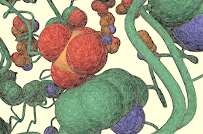Nature: the delicate dance of molecular interactions
Life is a complex tapestry woven from a myriad of intricate processes, many of which unfold at the molecular level within cells. Among the most fundamental of these processes are protein synthesis, cell wall construction, and DNA replication. Each of these events requires a delicate dance of molecular interactions where the right partners must come together at the right time and in the right concentrations, avoiding interference from other molecules.
Molecular mechanism of life
Protein synthesis, the process by which cells make proteins from amino acids, is a prime example of the complex choreography of molecular interactions. This complex process involves a complex molecular mechanism, including ribosomes, tRNA molecules, and mRNA chains. Each component plays a critical role in ensuring the accurate translation of genetic information into functional proteins.
Similarly, the construction of cell walls, which provide structural support and protection to cells, requires the precise assembly of various molecular components. These components, such as cellulose fibers and peptidoglycan chains, must align and interlock in a specific way to form a strong cell wall.
DNA replication, the process by which cells duplicate their genetic material, is another intricate dance of molecular interactions. This amazing process involves the coordinated action of numerous enzymes, including DNA polymerases, helicases, and ligases. These enzymes work in concert to unravel the DNA double helix, synthesize new complementary strands, and ensure accurate duplication of genetic information.
Evolution: perfecting the molecular symphony
Over billions of years, evolution has carefully refined these molecular mechanisms, ensuring their high efficiency and specificity. Due to the process of natural selection, organisms with more efficient and precise molecular mechanisms were favored, which led to the constant optimization of these processes.
This evolutionary improvement is manifested in the extraordinary precision of protein synthesis, the strength and elasticity of cell walls, and the precision of DNA replication. These processes are so precise that they allow cells to function with remarkable reliability, even in the face of environmental challenges and genetic mutations.
The intricate dance of molecular interactions in cells is a testament to the elegance and complexity of life. These interactions, honed over billions of years of evolution, orchestrate the symphony of life, ensuring the continuous renewal and reproduction of cells, the basis of all living organisms. As we continue to unravel the mysteries of the molecular world, we deepen our understanding of the delicate balance and exquisite design that underlies the very essence of life.




Comments
Post a Comment